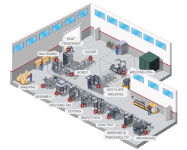Leak testing processes ensure the high-quality, consistent performance of products that need to provide a reliable seal at a set pressure level. However, there are many different types of leak tests, such as helium leak tests, mass extraction tests, and more. At AMD, we provide automation and manufacturing solutions for a wide variety of components and industries. Keep reading to learn more about the value of leak testing for production cycles and to identify the type of leak testing that best fits your company’s needs.
Types of Leak Testing Technology
There are eight major types of leak testing that your facility can use to ensure the integrity of products. They are:
Air Leak Testing With a Micro-Flow Sensor at Pressure Conditions
This leak test measures and replenishes lost air from products under test conditions. The test uses an integrated microsensor that can replace emitted or leaked air within a part or assembly so the test product stays under consistent pressure conditions. This helps measure the rate of air leakage.
Air Leak Testing With Mass Extraction (Vacuum Conditions)
Rather than holding the test product under standard environmental conditions, this test holds the product under vacuum conditions to identify and measure any leaks. The vacuum conditions make the test more sensitive and informative. It also uses a Micro-Flow sensor.
Helium Leak Detection
This test relies on a tracer gas that a field mass spectrometer can easily measure. A popular tracer gas is helium, as spectrometer units set to 4 amu can detect ionized helium to measure the severity of any leaks.
Ultrasonic Testing
Rather than measuring trace gases or direct air leaks, ultrasonic testing processes involve identifying any sound waves that indicate the presence of a leak. Leak sources generate ultrasonic signals that technology can use to uncover the location of the leak.
Thermal Imaging
Leaks cause temperature fluctuations when the body of the product, the internal fluid, and the surrounding environment have different temperatures. As a result, manufacturers can use thermal imaging via infrared cameras to detect the presence and location of any potential leaks in a test product.
Tracer Gas Detection
Tracer gas detection is a broader category of testing that includes helium leak detection. In these processes, helium, hydrogen, or another tracer gas, is used to find potential leaks. The gas moves throughout the test product and concentrates near the leak. Testers can then use technology to sense those concentrations and uncover leaks. This type of testing process is often used in plumbing, refrigeration, and HVAC systems.
Dye Penetrant Testing
For welds or joints that may have a leak, testers can apply a dye-penetrant substance to the area. Any leaks will draw the dye into the gap or defect, allowing testers to inspect the area and see the displaced dye under specific lights.
Acoustic Emission Testing
Similar to ultrasonic testing, acoustic emission testing uses sound waves to uncover the presence of potential leaks. Leaks can output acoustic signals and stress waves, which technology can then pinpoint.
Understanding Your Application
Leak testing is a vital process in many different industries. As a result, each industry or specific product may be subject to different testing requirements. These industrial regulations may guide the type of testing required, the quality control standards which must be met, and the maximum allowable leakage. Some industry-specific considerations include:
- Aerospace and Automotive: Some parts that often undergo leak testing include air conditioning systems, brakes, power train systems, heat exchangers, welded systems, and machined castings.
- Medical: Medical devices and implants, single-use disposal technologies like catheters, and laboratory equipment often undergo leak testing.
- Pharmaceuticals: Packages like vials must also be tested for leaks, as any potential leak is just as likely to allow microbial contaminants in as it is to allow pharmaceutical goods to leak out. Packages undergo helium leak detection tests to measure them against maximum allowable leak levels (MALLs).
- Consumer Electronics and Utilities: These products or systems are tested to ensure minimal risk of water contamination.
Factors to Consider
Because different products and applications require different types of tests, it’s important to select the right leak detection process for your company’s unique production or service needs. Consider the following:
- Leak test conditions: Different products must have or cannot have different pressurized leak conditions, either outside or inside the product.
- Environmental factors: The test environment will affect the viability of different tests.
- Cost: More complex tests are often more expensive than simple tests that can be done under diverse environmental conditions. Consider both the cost of the materials and/or service and the cost of preparing for the test.
- Throughput and cycle times: The speed of each test matters, especially if every part must be individually tested.
Learn More With AMD
At AMD, we’re here to help guide your leak detection test equipment selection to ensure you have the right tools and resources. Contact us today to learn more about our different leak detection test options or request a quote to start your order.

